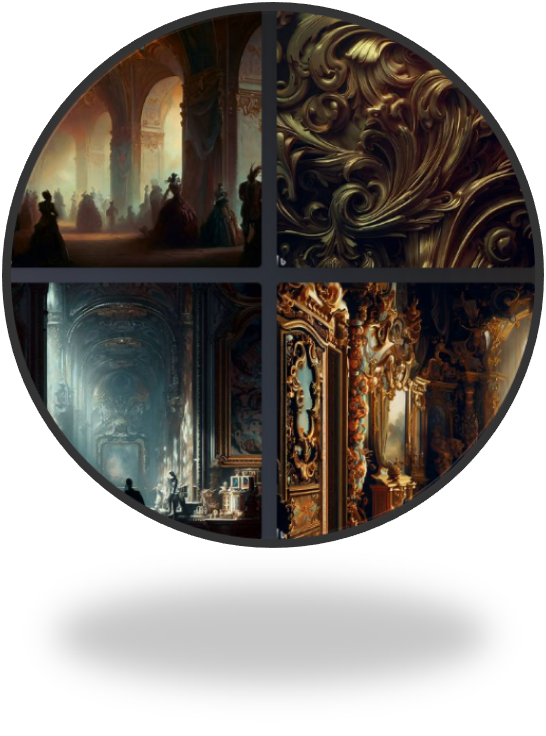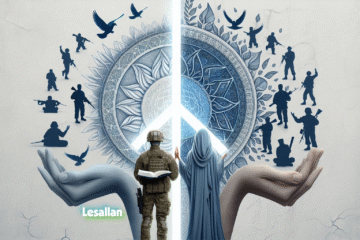Written and Revised By Lesallan
Student at Ohio Christian University
May 30, 2023

The Art of the Renaissance and Baroque Europe (Revised)
Written and Revised By Lesallan
Student at Ohio Christian University
May 30, 2023
The Renaissance and Baroque were two significant art movements that emerged in Europe following the Middle Ages. These styles had a profound impact on the arts and architecture, shaping the cultural landscape of Europe. It is worth noting that both movements had a strong focus on Judeo-Christian and Greco-Roman themes. However, a primary distinguishing feature between the Renaissance and Baroque periods is that Renaissance art emphasizes naturalistic and realistic representations of human forms and landscapes, whereas the Baroque period is known for its lavish details and grandeur.
Have you heard of Filippo Brunelleschi, the famous Italian Renaissance artist, architect, and engineer? He was well-known for his exceptional problem-solving skills and his impressive creations. One of his most notable works is known as the Cathedral of Santa Maria del Fiore, in the picturesque city of Florence. This architectural masterpiece, built between 1420 and 1436, features a magnificent dome that is a must-see for anyone visiting the area. Brunelleschi even invented innovative machines specifically for the project, which were successful in constructing the dome (Dewitte et al., 2018, pp. 461–463).
During the early years of his career in architecture, which spanned from 1410 to 1415, Brunelleschi discovered the principles of linear perspective. These principles revolutionized the world of art by allowing artists to include a single vanishing point in their paintings or drawings, causing all lines on the same plane to converge towards it. As a result, objects depicted in the composition appear smaller as they move further away into the distance. This groundbreaking concept gained widespread recognition and provided a new perspective on the depiction and understanding of space (Dewitte et al., 2018, pp. 461 – 463).
Masaccio’s “Tribute Money” painting is highly esteemed for its use of linear perspective and chiaroscuro techniques. His choice of colors and depiction of three-dimensional figures in three different settings transformed the art of painting. The shadows cast behind the characters on the left are especially impressive, and the level of detail on the characters’ feet is truly amazing. This is according to Dewitte et al. (2018), who discuss the painting in detail on pages 463-464.
In Quentin Metsys’ painting “The Moneylender and His Wife,” the wife can be seen turning a page in a religious book that contains Christian symbols such as the Virgin and Child, as well as the scales of Last Judgment. Many interpret the artwork as a moral condemnation of greed and a praise of honesty. The snuffed-out candle and fruit serve as symbols of original sin and death, while the carafe of water and rosary represents faith and purity. According to Dewitte et al. (2018, pp. 464-465), the wife’s distraction by her jewelry conveys the symbol of lust.
During the Late Renaissance, also known as the Mannerism period, artists had a distinct approach to their art compared to the High Renaissance. The High Renaissance artists focused on proportion, balance, and the ideal beauty in their works. Nevertheless, in the Mannerist movement, these traits were often exaggerated, leading to asymmetrical or unnaturally elegant compositions. Mannerist artists developed a unique style characterized by intellectual sophistication and artificial qualities rather than naturalistic ones. They had a self-aware cultivation of artiness and sophistication, which made their work stand out (Dewitte et al., 2018, pp. 471-472).
In Leonardo da Vinci’s masterpiece, “The Last Supper,” we witness Jesus’ final meal with His apostles before His arrest. The painting is a stunning portrayal of the diverse reactions of each apostle as Jesus reveals that one of them will betray Him. Moreover, da Vinci expertly captures the deeply symbolic moment when Jesus blesses the bread and wine, declaring them to be His body and blood. As a devout believer, I hold the sacrament of the Eucharist in high esteem. The transformation of bread and wine into the body and blood of Christ is a deeply significant and sacred ritual. It symbolizes His boundless love and offers forgiveness to those who have faith. This fills us with the incredible power and wonder of His love, as Dewitte et al.’s (2018) research on pages 474-475 attests.
Durer created this artwork after his conversion to Protestantism during the Reformation. It features the four apostles of Jesus Christ – John, Peter, Mark, and Paul – with Bible quotes inscribed at the bottom of each panel. The symbols associated with each apostle are also present: Saint John with an open book, Saint Peter with keys, St. Mark with a scroll, and Saint Paul with a sword and a closed book. Dewitte et al. (2018) provide more information on pages 475-476 of their source.
The San Carlo alla Quattro Fontane church, designed by Francesco Borromini, is a true masterpiece of Baroque art. Its innovative design showcases Borromini’s unique techniques, such as unexpected curves, hidden religious symbolism, and a modern take on classical architectural traditions. The Baroque style that emerged from this program was both sensual and spiritual, making religious imagery more accessible to the average churchgoer. However, it also incorporated dramatic and illusory effects to inspire piety, devotion, and a sense of the divine’s splendor, as noted by Dewitte et al. (2018, p. 479).
David, the biblical hero who defeated Goliath, has been depicted in numerous sculptures by renowned artists throughout history. Examples include Donatello, Michelangelo, and Bernini, whom each paid homage to this legendary figure in their works. Donatello’s 1440s bronze sculpture stands at around 5’5, while Michelangelo’s 1504 marble sculpture towers at seventeen feet. Bernini’s marble sculpture, created in 1623-24, stands at five feet and seven inches. Each artist’s representation of David reflects the values of their respective eras. Donatello and Michelangelo’s sculptures beautifully embody the ideals of the Renaissance, emphasizing humanism, individualism, and classical harmony. These sculptures serve as a testament to the timeless ideals of ideal beauty and creativity. On the other hand, Bernini’s sculpture reflects the Baroque period’s values of drama, movement, and emotion (Dewitte et al., 2018, pp. 480-481).
Depictions of David by various artists reflect the values and beliefs of their respective eras. Donatello’s David showcases the virtues of humanism and individualism upheld during the Early Renaissance. Michelangelo’s David epitomizes the ideals of beauty and classical harmony celebrated during the High Renaissance. Lastly, Bernini’s David highlights the dramatic, emotive, and dynamic values that characterized the Baroque era.
Baroque Era Music Terms
The term “cantata” in music refers to a vocal composition accompanied by musical instruments, often containing multiple movements, and featuring a choir. Its roots can be traced back to the early 17th century and derived from the Italian word “cantare,” meaning “to sing.” John Sebastian Bach’s talents as a composer are evident in the surviving cantatas, which contain some of his finest works. These compositions hold a special place in Bach’s repertoire, showcasing a wide range of expressions and musical styles. Bach’s ability to create dramatic religious music was also notable, particularly his mastery of a new form that was highly popular among German congregations (Forney et al., 2021, pp. 141-146).
During a German Protestant Church service, the congregation expresses their faith and devotion by singing a hymn accompanied by a Lutheran chorale. This musical accompaniment consists of a four-part structure, known as a chorale harmonization, with the sopranos and congregants singing the melody while the lower voices provide harmony (Forney et al., 2021, pp. 141–142).
A fugue is a musical composition that showcases counterpoint. It features a short melody or phrase, referred to as the subject, which is initially introduced by one part and then gradually picked up by others. The various parts interweave and develop the melody (Forney et al., 2021, pp. 170-172). These individual finds fugues appealing as they are played at a slow and rhythmic pace, without too many intense climaxes like other music from the same era.
Shape-note singing is a unique blend of social and religious music. It utilizes a special type of Western musical notation called shape notes, where each note head has a distinct shape to represent its scale degree and corresponding solmization of syllables like fa, sol, la, and others. This tradition has a rich history in American sacred music, going back to the 18th century. Singing schools, conventions, and day-long singing events are just a few of the musical occasions where shape notes have been closely associated (Forney et al., 2021, pp. 152-153).
Born in 1746 and passing away in 1800, William Billings was a highly regarded composer of early American primitive style. His musical creations have since become an essential aspect of American folk tradition. Billings was also the first American to make a career in music, publishing the first significant collection of original music by an American composer. Through his vibrant and innovative compositions, Billings made notable contributions to early American music, particularly with his beloved poetic hymns in the religious community (Forney et al., 2021, pp. 154-155).
The “Four Seasons” by Vivaldi is a collection of four violin concertos, each representing a different season of the year. These concertos were composed in 1720 and published in 1725 in Amsterdam. The music is accompanied by poems and is designed to evoke the feelings and scenes of each season through fast-slow-fast movements. Program music, like Vivaldi’s Four Seasons, tells a story through its composition and includes notes to help the listener form connections. The emotions and imagery of each season are clarified through sonnets (Forney et al., 2021, pp. 164-165).
Oratorio is a musical genre that shares many similarities with opera, including the use of an orchestra, choir, and solo singers. Both oratorios and operas incorporate choirs, soloists, and various characters. However, operas are typically performed on stage, whereas oratorios are reserved for concerts. Oratorios typically revolve around religious themes, while operas tend to explore historical or mythological subjects and can encompass themes like love, deception, and murder (Forney et al., 2021, pp. 135-139; 147-151).
Two prominent Baroque composers, Bach and Handel, were born in Germany in 1685. However, they had unique careers and compositions. Johann Sebastian Bach, a German native, lost his parents at the young age of ten and was raised by his brother. He was a virtuoso on the organ and Klavier. Despite not achieving fame during his lifetime, he created cherished pieces as a Kapellmeister for Anhalt-Cöthen, as reported by Forney et al. (2021).
Handel and Bach were both renowned composers but differed in their backgrounds and musical styles. Handel hailed from a middle-class Protestant family and relied on the support of aristocratic patrons to realize his ambitious musical projects. He began as a violinist and developed a deep love for opera after being exposed to many contemporary works. In contrast, Bach composed a variety of genres but did not venture into opera and focused more on instrumental pieces. Handel’s fame rested on his choral cantatas, while Bach was known for his polyphonic music. These distinctions in their compositions and styles are noted in Forney et al.’s work (2021).
As per this student’s opinion, there is no clear preference between Renaissance and Baroque music, since both have their own strengths and weaknesses. Though, comparatively, Baroque music tends to be more embellished than Renaissance music. Nonetheless, both eras have had a significant impact on history, and their importance can be appreciated in their respective forms of music.
The conclusion you see is that Bach stayed at home raising a family, while Handel sought to climb the social ladder of society in his day and time. Their journeys through life were very different. Bach had a woman and a life dedicated to the family. In Bach’s day, the responsibility in his world was that the woman took care of the children, the cooking, the cleaning, and child-rearing. Bach had more time to work on his music as his wife took on the responsibilities of everyday life. What happened to Handel? Towards the end of his life, Handel began to experience trouble with his sight. He managed with great difficulty to finish the last of his oratorios, Jephtha, which was performed at Covent Garden Theatre, London, in 1752. He kept his interest in musical activities alive until the end. After his death, he was buried in Poets’ Corner in Westminster Abbey. Is there anything else you would like to know about Handel?
References:
Dewitte, D. J., Larmann, R. M., & M Kathryn Shields. (2018). Gateways to Art: Understanding the Visual Arts (3rd ed.). Thames & Hudson.
Forney, K., Dell’Antonio, A., & Machlis, J. (2021). The enjoyment of music. W. W. Norton & Company.



